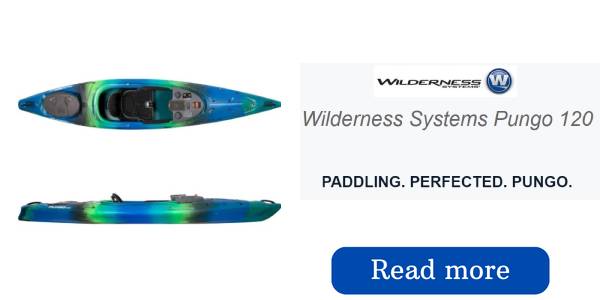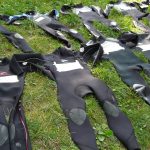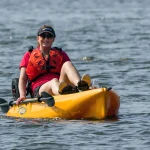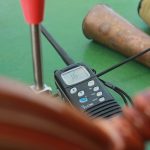Rafting down white water is an exhilarating and enjoyable recreational activity. Prior to your decision to go rafting, you should be aware of the levels of rapids associated with white water rafting.
A licensed rafting company and guide, who are knowledgeable in the rapids and experienced with the river, are essential for securely having a pleasant rafting experience, even for intermediate and advanced rafters.
No matter if you are a novice or a veteran to white water rafting, ascertaining the severity of rapids on the riverahead of your rafting journey is a great way to decide whether you can manage it in your present level of competence.
White Water Rafting Classes of Rapids
The American Whitewater Association was the originator of classifying white water rafting rapids, a system often used to designate rapids seen in the US and occasionally in other countries.
Class I
Class I rapids may not appear to be rapids in the least, but could be subsections of streams with a flow that is faster than cruising speed. This could result in slight tremblings or ripples of water, but will not typically make for a typical white-capped wave. Class I rapids can be navigated safely and easily by canoeists of all levels, with almost any type of kayak, with no danger involved.
In Class I, the level of complexity and significance is quite minimal. You have the ability to navigate your way down these rapids by whatever route you choose, and even if you end up falling into the water, you can swim through the rapid with minimal danger.
Class II
Class II water is one of the broadest classifications. The rapids can seem fairly insignificant and unimpressive, however, they can also be up to massive set of waves. In class II rapids, you will find nicely-ordered channels and streams which can be navigated in a straightforward manner.
This implies that you have the opportunity to position yourself at the beginning and go on the swift ride down to the final basin without needing to adjust your track in between.
Many people find Class II rapids the most enjoyable due to their lack of difficulty and hazards- making them less intimidating and demanding lower skill levels. Navigating a Class II rapid is straightforward and safe, however in contrast to class I, it may be best to beach your boat before swimming to shore.
Class III
Class III rapids require proficiency in using a kayak and you cannot merely rely on the water to decide which direction you take, unlike in Classes I and II. When navigating Class III rapids, you should expect to spot a path easily.
However, you will oftentimes be faced with an unexpected hindrance such as a rock, a tree, or a wave forcing you to alter your original plan. Class III is not suitable for new kayakers, making it the first grade that should not be attempted by novices.
It is possible to plan a maneuver to go around a class III rapid from the top and start your journey early, without actually needing to pass through the rapid, although you must still possess full control over your kayak.
The consequences in class III are usually low. A swim can be an uncomfortable experience, and you may stumble and bang against rocks, or you could get tossed around a bit, but generally you should come out all right.
When beginning to kayak on Class III rapids, it is commonplace for kayakers to examine the current beforehand, and may opt to have another kayak, or a person with a rescue bag, nearby in case of emergency.
Class III+
Class III+ bridges the difference between the level of difficulty of class III and class IV. A class III+ rapid will have the same level of challenge as a class III, but the flow will usually be steadier, necessitating you to make several connected maneuverings in order to safely navigate the rapid. There will still be a definite separation between class III+ and other categories.
An individual rapid consisting of a single shoot and a rock at the bottom would rate as a class III, however if this were expanded to be a five-hundred yard quick, then it would likely be considered a class III+.
In order to navigate class III+ whitewater, it is important to remain watchful and maneuver around the river in a pattern of alternating direction and speed, taking into account when to propel the kayak and when to make a turn in order to maintain the right direction.
Kayakers frequently break up their passage down Class III+ rapids by utilizing eddies behind obstructions to make the trip into smaller pieces.
Class IV
The fourth level of whitewater requires a skilled and knowledgeable approach to conquer. The path through a Class IV rapid is difficult to determine due to the numerous obstacles and shifts in the water current, yet the flow is consistent and there is always a way to safely pass through.
Class IV rapids typically involve a maneuver which demands precise maneuvering and technical proficiency.
Class IV rapids typically feature large waves from different directions, along with obstacles such as holes where water recirculates, and rocks that can be a potential danger. You must have complete mastery of your kayak when navigating class IV rapids, as the results of falling out could be perilous.
A dependable roll, which can be used to right oneself in a kayak, is considered essential for those who paddle in class IV rapids.
Class V
Class V rapids are thought to be incredibly dangerous, both in terms of the skill level required to navigate them and the potential outcomes.
The rapids usually have fast-flowing water or include areas with a significant drop or waterfall that require navigation around unavoidable hindrances such as holes.
Navigating Class V rapids has potential for hazardous results and necessitates both concentration and almost impeccable kayak management.
Assessing these rapids can be challenging at times as the whirlpools could be tiny and challenging to access. Setting up a safe environment and being able to be rescued in the event of an emergency can be a difficult undertaking, even for experienced kayakers.
Class V rapids should not be taken lightly. Although Class V rapids may appear to be plain sailing, they may have unseen swirls, more tricky eddies than expected, and maneuvers that are more difficult in reality than they seem to be beforehand.
One must have many years of experience as well as a thorough knowledge of rivers in order to paddle Class V rapids in a kayak.
Class VI
Until recently, rapids that were deemed impossible to navigate were categorized as Class VI. At present, only skilled kayakers are allowed to operate on Class VI rivers, and only at safe flow levels following extensive review.
It is virtually impracticable to save someone while traversing the rapids of Class VI and the consequences of not succeeding are immense.
Class VI waters can be quite erratic and choppy, making it difficult to successfully navigate through the rapids with limited time. It is not unusual for a rapid rated Class VI to be considered Class V after being run several times.
Who Decides the Grading?
Once the rapids are initially navigated or a guidebook is created, the paddler or the guidebook author can assign a rating to the rapid based on their viewpoint and the water levels of the river at the time.
Rapid courses can evolve with time, due to alterations in water levels, modifications in characteristics, or simply most people’s agreement. You should use your own discretion on the day of to determine if it is safe to navigate a rapid or the entire river.
Why Do Classifications Matter?
River categorizations are in place to support you in selecting a suitable river for yourself. It’s a convenient and uncomplicated means of determining if you should be looking at the river, similar to the classifications of ski runs or cycling paths.
It should not be assumed that a river can be safely navigated without knowledge or caution simply because it has been graded at a specific level.
A grade III river could be unique compared to other grade III rivers you may have canoed before; conditions such as its incline, how unbroken the rapids are, the height of the river, and how you are doing on that particular day can all be contributing elements to whether or not it is the right river for you.
River categories are also used to allow boaters to better comprehend what is going on beneath the surface of the water which creates the rapids. Understanding the features of rivers and rapids is a very important ability, first looked at ashore prior to navigating a rapid, then while running it.
Variations in White Water Rafting Classes
It is essential not to forget that the white water rafting levels mentioned above could be open to interpretation, and the level of difficulty may differ drastically in every class.
It is possible for the difficulty of navigating a river to vary substantially depending on existing conditions. For illustration, a basic easy rapid can become much more treacherous and perilous during a flood or when water is discharged from a reservoir.
Rapids can change in difficulty from one season to the next, or even from day to day, based on weather events. Verify that you evaluate the swiftness not merely overall, but on the specific day you plan to raft or swim it.
A part of rapids which has a certain overall class ranking might also have certain tricky stretches which would require greater levels of skill to navigate properly.
It’s essential to look into a rapid thoroughly prior to deciding to attempt it to check if you can cope with it, and always bear in mind that paddling down rapids can be dangerous.
Having a professional from a reputable outfitting organization inspect the rapids before you go white water rafting can provide reassurance as you go along the river or warn you against a hazardous trip.
How to Find Out Classes of Rapids
To work out the class a certain set of rapids is in, or locate rapids in a certain class, you will have to conduct some investigation.
Several rapids in the United States have been given official ratings from the American Whitewater Association. This list has been made official and can be relied upon as being accurate and exact.
This compilation has rapids that are situated in the Northeast, Southeast, Rocky Mountain, and West Coast areas of America.
The classifications for rapids not on the list can be somewhat subjective and may differ depending on the individual doing the categorizing. It is highly recommended that you verify the classification of a certain rapid by consulting a variety of dependable websites or outfitting companies before attempting it.
Choosing the Right Rapid Class for White Water Rafting
It is not advisable to attempt to navigate rapids that your boat or skills are not up to. To increase your chances of picking the right rapids class for you, consider these other tips:
- If you’re interested in rafting a river rapid, it’s essential to select one with an appropriate class for your skill and experience level, your physical fitness, and the equipment you have on hand.
- One mistake that novice rafters make is to assume that the higher class a rapid falls into, the more “fun” or enjoyable the rafting experience will be, but this can often be the opposite of the truth.
- Rapids are ranked more highly not based on the speed of the water or based on the features that make rafting enjoyable but strictly based on the level of danger rapids present, in the shape of things like obstacles and unpredictable currents. With that said, prioritize safety over fun when choosing a class.
- Do some research or scouting (or both) of rapids ahead of time to identify any obstacles to keep an eye out for once you hit the water.
- Especially if you’re new to rafting, consult with a professional or outfitter to determine whether navigating a particular rapid will be safe under its present conditions.
- Pay attention to the sub-classes of rapids to get a better sense of precisely how difficult a particular rapid will be, and always work your way up to more difficult rapids if you’re a novice.




